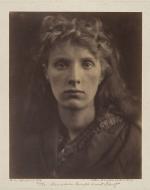Created by Maya Parekh on Fri, 10/23/2020 - 12:22
Description:
One of Julia Julia Margaret Cameron’s well-known and photographs is entitled The Mountain Nymph of Sweet Liberty and it depicts a pale woman with flowy hair, from the bust up, looking directly at the camera. It was taken in 1866, three years after Cameron was gifted her first camera, and a 14 1/8 inch x 11 1/8 inch print of the photograph is currently displayed at Dimbola, Cameron’s former house (Detjen 57). The title of the portrait is in reference to lines from a poem titled L’Allegro by Jon Milton, “Com, and trip it as ye go / On the light fantastic toe / And in my right hand lead with thee / The mountain nymph, sweet liberty” (Detjen 58). Although Cameron typically titled her portraits of men after their names, her portraits of women were most commonly titled with reference to religion, literature, or other figures, without revealing their identity, revealing how Cameron, while at times challenging social hierarchies by working with her maids and lower-class people, still perpetuated cultural notions about not allowing women to have as strong of an independent, let alone prideful, identity as men were allowed (Hager 204).
The woman in the photograph is surrounded by darkness but her face is well-lit. The photograph is in black and white but the woman looks like she has pale hair and light eyes. She is expressionless, with a slight hint of seriousness. Some would describe her gaze as a “penetrating meditative stare” (Hager 203). She is wearing layers and it looks like she is wearing a coat or a jacket with buttons, though most of her body is cut off. Although the woman has sharp features, there is a softness to the way she is depicted in the photograph. This softness aligns with Cameron’s values of domesticity and femininity (Detjen 65). It was culturally common for women in photographs to be depicted as representations of cultural feminine ideals, such as piety, virtue, romantic love, desire, frailness, and a level of vulnerability that encapsulates enough strength to prevent men from being tempted to profess interest in them in an inappropriate manner (Hager 204). This is reflected in the gentle, yet firm, stance and disposition of the woman posed in the photo.
The model in the photograph was named Annie Keene and came from the English lower-classes (Hager 199). This is signaled by the way Cameron has styled the woman’s hair. As described in Victorian Fashion, during the 1860’s hair was drawn back off the face. It was common and considered beautiful for hair to be shaped into complicated and ornate styles and “neat, jaunty hats” were worn as well (Shrimpton 19). In contrast to these sophisticated and popular styles, the woman in the photograph wears her hair down and flowing over her back, which might be could be due to her class status.
Cameron is known for having her photographs be intentionally slightly out of focus (Detjen 70). This slight blur was achieved by forgoing focus adjustments and she did not prevent the subject from moving by having them sit down or hold on to something. This slight blur is said to give her portraits “the breath of life” (Centeno et. al 164). The darkness in the background of the image helps to emphasize the liveliness and the life that Cameron desired to bring into her photos and concentrate the viewer’s focus on the woman’s face. Some critics have questioned whether the lack of focus was on purpose, or whether it was due to Cameron’s inability to handle the camera, which would have been large, heavy, and complex at the time (Hager 204). Cameras were constructed out of wood, leather, metal, and glass and the negatives of the image were used in a salt and silver solution, which could capture in image in as quickly as 20 seconds, but Cameron had her posers be in front of the camera for much longer, which often naturally resulted in photos with slight blurs, such as this one (Centeno et. al 164). It was also unrealistic for sitters to smile for Cameron, since she would sometimes have them posed for several minutes at a time, which is one reason why the woman in the photo is not smiling (Hager 204). The woman in the photograph is also close-up to the camera, drawing attention to her beauty. Capturing beauty within photographs was important to Cameron and explains why she has chosen to focus on the face of the woman being depicted (Witcher 206).
Works Cited
Detjen, Alice. “Transforming the House: The Photography of Julia Margaret Cameron.” Housing Capital, 2017, pp. 56–71., doi:10.1515/9783110532241-004.
Witcher, Heather Bozant. “‘Art of the Future’: Julia Margaret Cameron's Poetry, Photography, and Pre-Raphaelitism.” Victorian Studies, vol. 61, no. 2, 2019, p. 204., doi:10.2979/victorianstudies.61.2.04.
Images Cited
Cameron, Julia Margaret. “The Mountain Nymph of Sweet Liberty.” The Metropolitan Museum of Art, www.metmuseum.org/art/collection/search/268697.


